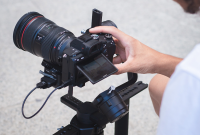Understanding the Operation of Digital Cameras
Capturing beautiful moments and making them readily available is no longer the exclusive domain of the wealthy. The majority of us have instant access to our most memorable memories by just clicking on a button. Digital cameras allow you to save a significant amount of time. Once the photograph has been shot, it is just a matter of downloading the photographs to a computer and making them available on the internet in a variety of ways. Images captured and stored with digital cameras are in the form of digital files. Capturing images is often performed with the use of a photosensor, which is connected to a charged pair device (CCD.) Using your computer, you may edit and save the images to a compact disc or hard disk once they have been transferred from your camera.
Photographs taken with digital cameras may be preserved indefinitely since they are captured in real-time. Delete photographs that you don’t want easy. There is no need to purchase films. You are not required to print every photograph; instead, you have total discretion over the final print after editing on a personal computer. There are no concerns about negatives being spoilt or lost. It is possible to keep a large number of photographs without needing to replace or purchase the film.
There are a plethora of different digital camera brands available on the market today. Sony, Canon, Olympus, Nikon, Kodak, Minolta, and Fuji are just a few of the brands available. These are a handful of the most well-known brands in the world. There are several features, settings, and menus available on even the most basic digital camera models. This makes it tough for novices to choose the most appropriate camera for their requirements. Digital cameras are available in a variety of pricing ranges, with the number of functionality they provide dictating the price. In order to begin comparing the features, you must first choose the reason for which you want to utilize your digital camera. Starting your search on the internet is the easiest method to ensure that you see all of the sites that provide feature and pricing comparisons for various kinds and brands of digital cameras.
Almost all digital cameras now include live-preview technology, which means that a screen is built into the camera so that you can see a preview of the picture that you just snapped while still holding the camera. The term “megapixel” refers to the most widely compared attribute in digital cameras. This refers to the number of pixels in millions of pixels. The result is that an eight-megapixel camera would contain eight million pixels. Additionally, optical and digital zoom capabilities, communication with other devices like computers and printers, and internal and external storage space as well as compatibility with memory cards, batteries, and picture file formats are all key considerations when comparing cameras.
Numerous digital cameras have communication options such as USB port, FireWire port, USB PTP mode, Bluetooth, and Wi-Fi, among other options. Many digital cameras now have a PictBridge mode, which enables you to print directly from your digital camera without the need for a computer or any other software. Despite the fact that all cameras have a limited quantity of internal capacity, extra memory cards are necessary to save more images. In this category are Micro Drives or Compact Flash memory cards, which are often seen in high-end professional cameras. Memory Stick by Sony is a proprietary flash memory card that can only be used by Sony products. SD/MMC, Mini SD, and Micro SD cards are the most common types of memory cards used in commercial digital cameras.
Choosing a camera with automated settings and functions is recommended for those who are just starting out as amateur photographers. This will assist you in taking the appropriate photographs depending on the quantity of light and the scene without exerting excessive effort. However, if you are seeking a professional camera, you should search for one that enables you to manually choose all of the shooting settings. Landscape, portrait, panoramic, action settings, night mode, beach mode, snow mode, and sunset/sunrise modes are just a few of the shooting modes available on the newest digital cameras, which include landscape, portrait, panorama, and action settings.
JPEG, TIFF, DNG, and other popular image formats are available for exporting the final picture output, among others. Videos are most often stored in one of the following file formats: AVI/DV/MPEG/MOV/WMV/ASF/MP4/AAC.



